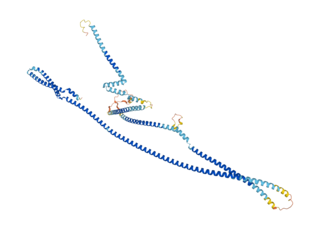
ADP-ribosylation factor 1 is a protein that in humans is encoded by the ARF1 gene.

Cux1 is a homeodomain protein that in humans is encoded by the CUX1 gene.

Golgi-associated PDZ and coiled-coil motif-containing protein is a protein that in humans is encoded by the GOPC gene.

Coatomer subunit gamma is a protein that in humans is encoded by the COPG gene. It is one of seven proteins in the COPI coatomer complex that coats vesicles as they bud from the Golgi complex.

Golgin subfamily A member 3 is a protein that in humans is encoded by the GOLGA3 gene.

Golgin subfamily A member 4 is a protein that in humans is encoded by the GOLGA4 gene.

ADP-ribosylation factor 5 is a protein that in humans is encoded by the ARF5 gene.

AP-1 complex subunit gamma-like 2 is a protein that in humans is encoded by the AP1G2 gene.

Chorion-specific transcription factor GCMa is a protein that, in humans, is encoded by the GCM1 gene.

BET1-like protein is a protein that in humans is encoded by the BET1L gene.

Conserved oligomeric Golgi complex subunit 3 is a protein that in humans is encoded by the COG3 gene.

Conserved oligomeric Golgi complex subunit 7 is a protein that in humans is encoded by the COG7 gene.

Galactosylgalactosylxylosylprotein 3-beta-glucuronosyltransferase 3 is an enzyme that in humans is encoded by the B3GAT3 gene.

Conserved oligomeric Golgi complex subunit 4 is a protein that in humans is encoded by the COG4 gene.

Lactosylceramide 4-alpha-galactosyltransferase is an enzyme that in humans is encoded by the A4GALT gene.

RAD50-interacting protein 1 is a protein that in humans is encoded by the RINT1 gene.

Conserved oligomeric Golgi complex subunit 8 is a protein that in humans is encoded by the COG8 gene.

Conserved oligomeric Golgi complex subunit 5 is a protein that in humans is encoded by the COG5 gene.

Conserved oligomeric Golgi complex subunit 2 is a protein that in humans is encoded by the COG2 gene. Multiprotein complexes are key determinants of Golgi apparatus structure and its capacity for intracellular transport and glycoprotein modification. Several complexes have been identified, including the Golgi transport complex (GTC), the LDLC complex, which is involved in glycosylation reactions, and the SEC34 complex, which is involved in vesicular transport. These 3 complexes are identical and have been termed the conserved oligomeric Golgi (COG) complex, which includes COG2.

Caveolin-2 is a protein that in humans is encoded by the CAV2 gene.




















